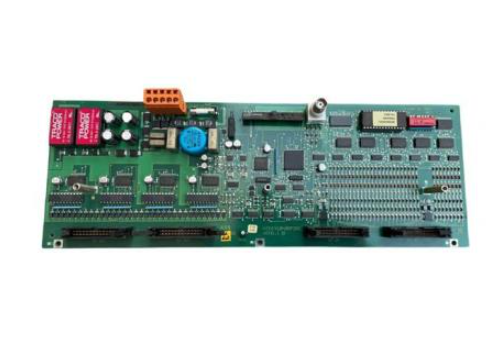As the core component of ABB control system, the UFC911B101 control board mainly undertakes key tasks such as signal processing, logic operation, and equipment linkage control. It is an important bridge connecting on-site sensors, actuators, and upper control systems. Its specific application scenarios include but are not limited to:
-Power system: used for excitation control of generator sets, turbine regulation, monitoring and linkage control of substation equipment status, ensuring the stability of power production and transmission.
ABB UFC911B101 3BHE037864R0101 control board
Product core positioning and application scenarios
As the core component of ABB control system, the UFC911B101 control board mainly undertakes key tasks such as signal processing, logic operation, and equipment linkage control. It is an important bridge connecting on-site sensors, actuators, and upper control systems. Its specific application scenarios include but are not limited to:
-Power system: used for excitation control of generator sets, turbine regulation, monitoring and linkage control of substation equipment status, ensuring the stability of power production and transmission.
-Process industry: Real time collection and precise control of process parameters such as temperature, pressure, and flow rate are achieved in chemical, metallurgical, and other production processes to ensure the continuity of the production process and product quality.
-Intelligent manufacturing equipment: provides logical control support for robot workstations and automated production lines, enabling collaborative operations and precise motion control between devices.
-Industrial automation upgrade and transformation: As the core component of upgrading old equipment control systems, it can quickly adapt to existing equipment interfaces, improve system control accuracy and intelligence level.
Core functional features
The UFC911B101 control board integrates ABB's advanced industrial control technology and has the following outstanding functional features to meet the demanding requirements of industrial scenarios:
1. Efficient signal processing capability
Support real-time acquisition and processing of multiple types of input and output signals, including analog signals (such as 4-20mA current signals, 0-10V voltage signals), digital signals (switch signals), etc. The signal sampling accuracy is high, the response speed is fast, and it can accurately capture the operating status changes of on-site equipment, providing reliable data support for control decisions.
2. Stable and reliable logic control
Built in high-performance microprocessor with powerful logical operation and data processing capabilities, capable of implementing complex control algorithms such as PID regulation and sequential control. At the same time, the product adopts industrial grade hardware design standards, with strong anti-interference ability, and can operate stably in complex industrial environments such as voltage fluctuations and electromagnetic interference, reducing the risk of system failures.
3. Good system compatibility
Compatible with ABB's mainstream industrial control systems (such as AC800M, Symphony Plus, etc.), supporting standard industrial communication protocols (such as PROFINET, Modbus, EtherNet/IP, etc.), it can quickly integrate with existing control systems, reducing system integration difficulty and cost. In addition, its standardized interface design also facilitates interconnectivity with third-party devices.
4. Convenient debugging and maintenance
Support parameter configuration, program writing, and fault diagnosis through ABB's dedicated debugging software (such as Control Builder M), making the debugging process intuitive and efficient. At the same time, the control board has a complete self diagnostic function, which can monitor its own operating status in real time. When a fault occurs, it can output an alarm signal in a timely manner, which is convenient for operation and maintenance personnel to quickly locate the problem and handle it, reducing equipment downtime.
5. Industrial grade environmental adaptability
Adapting to the harsh environmental conditions of industrial sites, with a wide working temperature range (usually -20 ℃~60 ℃, subject to product manual), it has good dust, moisture, and vibration resistance, and can stably serve in industrial scenarios in different regions and working conditions.
Key technical parameters
The following technical parameters are typical specifications of the control board of this model, which are subject to the product manual officially released by ABB:
parameter category
Specifications
power input
DC 24V (allowable fluctuation range: 18V~32V)
Analog input
8 channels, 4-20mA/0-10V optional, accuracy ± 0.1%
Analog output
4-channel, 4-20mA, load capacity ≤ 500 Ω
Digital input
16 channels, NPN/PNP compatible, response time ≤ 1ms
digital output
8 channels, relay output (capacity: 2A/250VAC)
communication interface
1 Ethernet, 1 RS485 (supporting Modbus RTU)
Operating Temperature
-20℃~60℃
Storage temperature
-40℃~85℃
Protection level
IP20 (panel installation status)
Installation and usage precautions
1. Installation specifications: Installation should be carried out in accordance with the requirements of ABB product manual, ensuring that the control board is firmly connected to the installation guide rail to avoid vibration effects; The installation location should be far away from strong electromagnetic interference sources (such as high-power motors, frequency converters, etc.), while ensuring good ventilation and avoiding high temperature accumulation.
2. Wiring requirements: Before wiring, it is necessary to confirm that the power supply voltage is consistent with the rated voltage of the control board. The input and output signal lines should be wired separately from the power lines to reduce interference; The wiring terminals need to be tightened to prevent poor contact from causing signal abnormalities or equipment failures.
3. Debugging points: Before the first debugging, it is necessary to conduct a visual inspection of the control board, confirm that there is no damage, and then connect the power supply; When configuring parameters through debugging software, it is necessary to strictly follow the control logic requirements to avoid equipment misoperation caused by parameter errors.
4. Maintenance suggestion: Regularly clean the control board to remove surface dust; Regularly check the fastening status of wiring terminals and the insulation condition of the circuit, and promptly address any issues found; It is recommended to establish a device operation ledger to record the operating status and fault conditions of the control board for subsequent maintenance.

- User name Member Level Quantity Specification Purchase Date
- Satisfaction :
-









Email:wang@kongjiangauto.com




































































































































